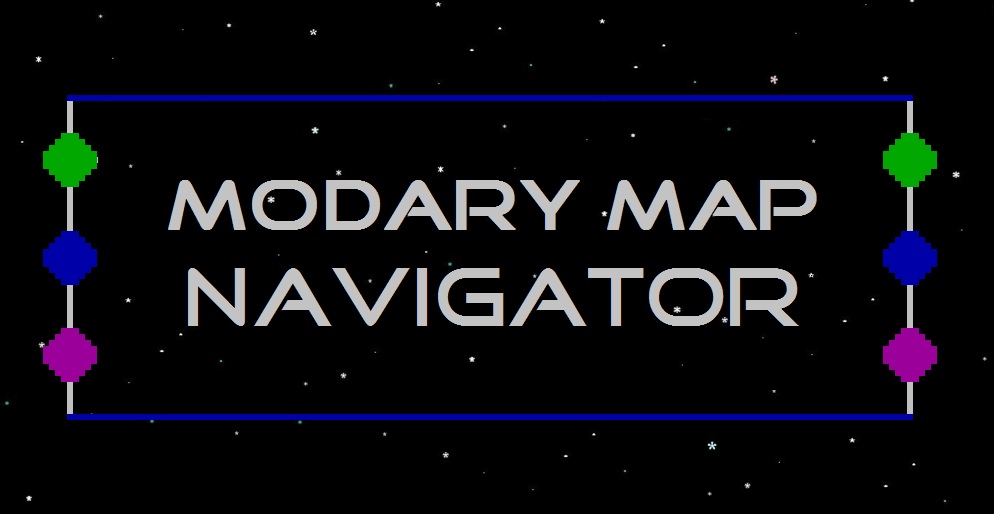

|
The Modary Map™ contains the system's 119 qualified modal-scales, and the maprelates to the notes of an instrument, mechanically, like a slide-rule. Since the map is larger than the Note-Strip, the strip is depicted as the part that slides; although, since the notes of an instrument are fixed, it is actually the map that slides. The following figure is a portion from the map; it shows significant datarelevant to the system's Main Spectrum. This spectrum contains the Major Scale [Main Orange]and the Natural Minor Scale [Main Blue] and their modal relatives. This figureindicates the 100% value with an 'x' symbol. In the simulator to follow, the values of the modes are adjusted to include the underlying chord. |

Figure 3.2 : Sample Spectrum from the Modary Map
|
The Modes are depicted with Dot-Notation since they each can be rooted upon any of the 12 chromatic notes. The notes in the strip, however, are aligned not with the Dot-Notation but rather with the Modary Map's prescribed values. Each of the map's 12 columns possess certain fixed values for each mode, representing the specific degrees at which each mode is pertinent to each of the 12 relative chromatic points. Each of these points is accredited to and is labeled as a square with a specific color, and each square takes on a unique character since it permanently possesses all the values in its vertical column. The intervallic relationship between the colors and their order remain fixed, thereby revealing an otherwise hidden relationship between the modes, and such fixed nature holds true for all 119 Modes contained in the System's Map of Music Harmony. Although the Map is fixed in form, it is able to accurately account for many of the perceptive-forces involved in chromatic harmony which stem from an underlying force broadly termed modulation. By occurring in multiples of itself and aligning with multiple chromatic locations simultaneously, the map is able to provide a detailed description of harmonic relationships. This will be easy to understand and is the central feature of the Modary System™. 
The twelve points are specifically characterized to make it easy to identify them. They remain beside each other in a fixed relationship as relatives and slide together between various root-notes during any modulation. All values each Characterized Point possesses in its column will accompany it at all times. The quantified relationship between the Modes and the 12 Characterized Points remains fixed. We may associate the characterized points to any related objects in the tangible world; with the planetarium concept, they are celestial bodies within our solar system. |
|
Orange |
Earth |
* |
* |
Black |
Mercury |
|
The bass-note (not always the lowest note) that is occurring always adopts the point of view due to acoustics. The Bass-Points are ultimately the ones that are addressed with the values denoted by the Map. By adding certain notes above the Bass-Point, through the process of elimination there is some increase in certainty as to which modes are presently applicable, thereby increasing the certainty as to which of the 12 points are participating the most in the manifested harmony; the result is a specific inclination for the Map to realign. Such a realignment of the Map provides a change in perspective, from past to future, regarding the underlying relationship between Harmonic Forms; therefore, a modulation occurs and it can be tracked with great detail with this system. The map indicates the triad-chord types since only the modes containing a particular chord or harmonic form will be relevant to that chord or harmonic form. The modes of the map can be listed in any order with or without all modes present and the map would still function considering such mode. For example, when a major chord is being played, one need only use the modes with the major chord; so only those modes need to be listed at that time. 
The chords indicated: major, minor, augmented, diminished, neither. Since most music does not consist of a constant strand of full modes, there is usually much uncertainty going on during a piece of music; when a chord has potential to be in two map-locations simultaneously, the potential for a modulation is at hand. To fully account for a situation of harmony, all 12 Characterized Points are to be regarded simultaneously with a technique called 12-Point View. Detailed information is thereby provided which can account for other perceptive-forces such as multimodality, and even suspense versus resolve. Computerized assistance can make calculations for the system's user and present the most relevant data first. The 'Navigator' concept is provided in this website to give some insight into the Modary System's theory of operation. The system's software conveys to musicians the results of many calculations regarding an extensive database that is made available by the system regarding various harmonic forms, in order to provide the system's user with an in-depth view into harmony. The following 'Navigator' demo depicts only 24 of the system's 119 Modal Scales and prescribes for only Major and Minor Triads rather than the comprehensive variety of chord structures respected by the system. |
|
The Modary Map Navigator can be sampled at the Color-Guitar website: 

The Modary System™ is seeking financing. © 2022, Zach Pendulum & Tonentity Publishing™ |